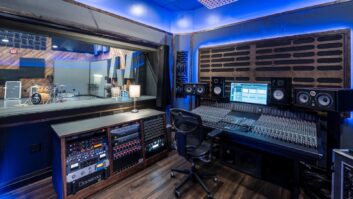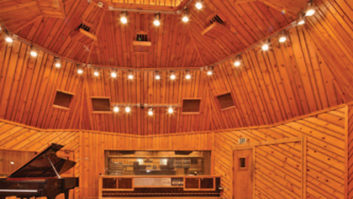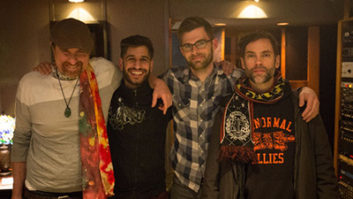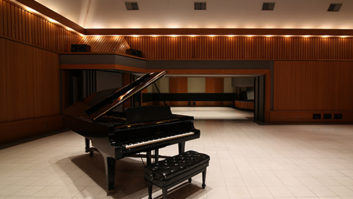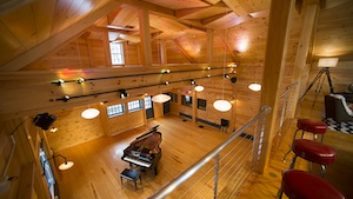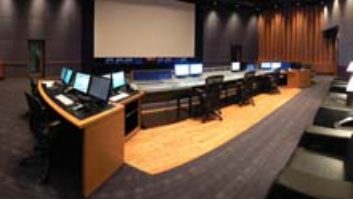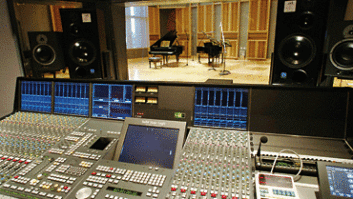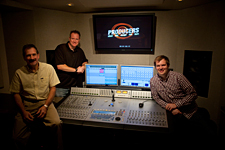
Producers’ audio mix engineers, from left: Bob Bragg, Mike Brilhart, Tim St. Clair
In the closing weeks of the summer of 2009, Producers Video Corporation in Baltimore, Md., a company offering full audio and video services to broadcasters and advertising agencies—from location shooting to audio and video post-production—completed a major overhaul of its audio facilities. “We took each of the two rooms down for less than two weeks, and then we were back up and doing jobs,” says Producers’ senior audio engineer, Bob Bragg. “The whole upgrade path was spread out over five weeks. It was still a challenge to pull that off without a disruption in the business.
“Because we’re full service, we pride ourselves in being responsive,” Bragg continues. “We have two Avid rooms and two Final Cut rooms, plus three graphic designers. I would say the bulk of our work is in the advertising realm—regional and national commercials. We do a lot of ADR. We have ISDN so we’re able to do dialog replacement to picture remotely for when actors are in town, coming through Baltimore.”
As part of the upgrade, Producers installed two Fairlight Constellation XCS consoles, featuring a Xynergi center panel running on Fairlight’s latest Crystal Core (CC-1) engine.
“Before choosing Constellation XCS, we thoroughly investigated every major integrated professional audio product on the market,” Bragg says. “In the end the Constellation consoles won out because there were no other products on the market that offered such an extensive range of features at such a cost-effective price point.”
Previously, Producers used Fairlight’s QDC/FAME systems.
“We’ve always striven to have as much integration in our equipment as possible—that’s what pointed us to the FAME systems back in 1997, because we liked the integrated mixer/editor concept,” Bragg adds. “Fairlight has now taken it to the next level by adding HD video in the timeline, flexible file import/exporting and VST plug-ins. In post-production these days everything is all about workflow. Speed and flexibility are absolutely vital, and Fairlight has really taken this seriously with all the new features it has incorporated into Constellation XCS. Even our multiple-terabyte FX library is integrated within the box with AudioBase3. We don’t have to switch applications to search our sound libraries and spot them into a project, which is a major advantage, as it saves us so much valuable time.”
Bragg adds that having the ability to ingest picture and import and export most file formats is also helping to speed up workflow, leaving the facility’s staff free to get on with the job and deliver the finished project to the client more quickly for final approval.
“I also like having a variety of EQ and dynamics on the channel strip of every channel without having to load a single plug-in,” Braggs says. “This saves time, plus the native processing sounds sonically superior to most of the plug-ins that I’ve used on other systems.”
Bragg says that, as a longtime Fairlight user, he has adapted easily to the built-in Xynergi interface and the new CC-1 engine. Less experienced engineers have also taken to the system quickly because it is intuitive to use.
“We set up our first Constellation system for training several weeks before the installation so that we could provided our engineers with training time without the normal pressure of a busy day with a client,” he says. “I would advise any other facility with the space to adopt a similar approach, because it does give staff an opportunity to become familiar with this new technology. Having said that, the Xplain help buttons and the unrivaled support we’ve gotten from FairlightUS really helped us get to grips with CC-1. Now we’re comfortable with the general operations and we’re continually adding the advanced features to our skill set.”
Bragg says that Producers’ audio engineers are excited about the ADR features on the new Constellation systems. “It has beeps, streamers, and even support for onscreen script,” he says.
In keeping with any facility that is moving to a more up to date technology platform, there is always the worry that archive material might not be compatible. Producers Video was concerned about this because it has 12 years of archived projects that that require client access.

Producers’ Audio Two room features a new Fairlight Constellation XCS console and Genelec 7070A subwoofer
“It turns out that our concerns were unfounded, because Fairlight has
made the legacy projects loadable in the new editing format,” Bragg
says. “In our first week with the new equipment we had a client who
needed to re-edit and update work from 2003. It was seamless.”
To learn more about Producers Video’s upgrade project, Mix recently spoke with Bragg by phone.
Clearly, Fairlight’s new Constellation XCS system is at the heart of your facility’s upgrade.
Having
HD video in the timeline is exciting for me—to be able to drag an HD
video clip to the timeline or ingest it myself just speeds the
workflow, and that’s really what the business model seems to be in
post-production these days. People have X amount of dollars for a
project and usually a tight deadline, too, so any tool that you can
have in your hand to pull that off for the client is great. There used
to be a time when [this] business had a cycle, and you could predict
it, but that paradigm is gone [laughs]!
We’re excited about this platform. We have a long history with
Fairlight, and that was a big part of our decision to look at their
equipment again when we decided to do the upgrade. But we did look at
everything out there. I think there may be 20 systems or so in the U.S.
made up of what we have—the Constellation interface with the Crystal
Core card and a CPU, and there are probably a lot more Xynergi systems
out there.
One of the big things for Fairlight is their tech support. I can pick
up the phone and call somebody and get an answer for a question I have,
or support for any problem we’re having. There are few companies out
there that do that in this business climate. The other engineers and
myself have given some input to Steve Rance, the president of
FairlightUS, about features that we would like to see added and he
takes those suggestions seriously. That’s the kind of responsiveness
that we appreciate.
Could you comment on other aspects of your upgrade? What other
equipment did Producers Video purchase in addition to the Fairlight
consoles?
We bought two new Gordon Audio Model 5 mic pre’s,
which is a very clean front end, with a GC32 remote control. Because
we’re located on what’s considered “Television Hill” in Baltimore,
we’re concerned about RF here at our location. The preamp is in the
voice-over booth, so the length of mic cable run is 10 to 12 feet. If
noise is going to get in, that’s generally where we see it getting in,
at mic level. [The Model 5] was amazingly transparent on all the mics;
it’s a totally uncolored sounding mic pre. These days, if you want to
add color you can easily pull a plug-in or do some processing in post.
We like to have as transparent a sound recorded to start with, and then
we can always dirty it up if that’s what the track requires.
We bought a few bundles of Waves plug-ins, as well, and are really
happy with the L316 [Multimaximizer] bundle for mastering. We also
updated our sound effects collection. We have a multiple-terabyte
server that we search sound effects on, and so we added the Sound Ideas
Ultimate SFX Collection, which comes on a hard drive and is about a
terabyte. We added that to our server, and we can search those sounds
not only from our two Fairlight Constellation rooms—Fairlight has a
software search engine built into the desk called AudioBase—but also,
with SoundMiner [software-based asset management system], we search the
same sounds from the server in our Pro Tools rooms.
We added HD sync, as well. We purchased a Brainstorm Electronics DCD-8
sync generator with the VSG-4 HD sync card.
These are little machine room items that you need to deal with when
you’re doing an HD upgrade. We’re on a different floor than the other
departments—audio is on the second level and the edit and production
rooms are on the first level—so we like to have our own sync
generation up here. We also added a Genelec 7070A subwoofer. We have
Genelec monitoring in all of our audio rooms, and in the video rooms as
well. We have some older 1037B three-way monitors in the audio rooms
and in making the transition to 5.1 mixing added a subwoofer to the
Audio Two room. It’s very sweet and is just a natural addition to those
other Genelec speakers.
For more information, visit www.producersvideo.com and www.fairlightus.com.
